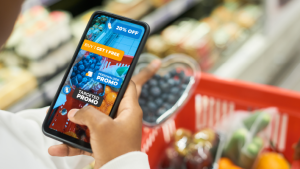
How Leading Retailers are Overcoming Promotion Challenges and what is in Store for 2023
A retail buzz phrase we heard and read often in 2022 was, “The future of retail is here”. Leading retailers today are investing in innovative
As the holiday season approaches, retailers take preparatory measurements and tailor their holiday promotions for the most action-packed time of the year. With spending anticipated to hit $1.56 Trillion this year, the holiday season represents an ample opportunity for businesses to capitalize on due to its huge impact on boosting sales and driving revenue.
However, with the emerging trends and shifting consumer behavior, retailers need to identify these patterns and act accordingly by leveraging new technologies and implementing modern and smart promotion management methods and tools to gain a competitive edge.
This blog explores the trends that define this year’s holiday season and the factors that draw the consumer path to purchase. It also serves as a retailer’s guide to master holiday promotions, with AI-centric insights that will elevate your promotion game and lead you out of the outdated management systems maze.
This year’s consumer interests and shopping trends are affected by the eco-wakening and the increasing demand for sustainable retail, the growing interest in online shopping, and the new shift towards a more cost-conscious shopping approach.
Online sales are expected to grow between 10.3% and 12.8% this year, altering the consumer’s shopping habits and increasing demand for personalization. The COVID-19 online shopping boom has blurred the line between in-store and online shopping, pushing both retailers and consumers to all types of online transactions, and shifting towards digital consumption.

With 83% of consumers planning to start their holiday shopping between August and Thanksgiving, retailers initiated their holiday promotions earlier than usual this year. The post-pandemic era formed new habits and behavioral patterns, as consumers are trying to dodge any possible stock shortages, while others are simply looking to avoid large crowds in stores.

Consumers are more likely to look for alternatives once the stated price is higher than expected. With the intensified omnichannel competition in the retail track, tight-fisted customers seamlessly bounce between multiple online and offline channels, checking reviews and using price comparison websites like Google Shopping to find the best deals. Consumers leverage AI-powered benchmarking tools to track the price of their favorite items and make the purchase once it hits its lowest point.

With the rising tide of support for a reduced environmental impact, consumers are changing their shopping habits and taking a sustainable turn. As per a report by IBM, 70% of consumers are willing to pay extra for eco-friendly items like organic materials or products manufactured using safe and non-polluting processes.
Lidl curated a set of sustainability initiatives to promote efficient use of resources during the holiday season, developing a circular packaging system and ensuring an energy-efficient supply chain. The company is working on a sustainability strategy with measurable targets and well-identified metrics, aiming for a carbon-neutral supply chain and a major waste reduction across all operations.

According to Deloitte’s annual holiday retail forecast, holiday spending for 2023 is expected to increase between 3.5% and 4.6% compared to the last year. Despite the soaring prices and the headwinds of elevated interest rates, consumers are still in the saddle and willing to hunt for holiday promotions and deals. In the event you’re still contemplating, here are some of the reasons contributing to the increase in holiday spendings:
The Personal Consumption Expenditures (PCE) US price index grew by 3.3% in 2023, eroding the purchasing power of the dollar over time and forcing consumers to adjust their spending habits and opt for holiday promotions to cope with it. Due to the diminishing purchasing power, Americans are willing to open their wallets for more practical retail items and gifts, while spending less on vacations and luxurious items. Simply put, consumers are maintaining healthy holiday spending budgets in the midst of economic uncertainty and inflation.

In the presence of enticing deals, tight-fisted consumers tend to make purchasing decisions based on their fear of missing out (FOMO) on holiday promotions, magnifying their purchase intent and falling for this pervasive apprehension. As a result, they make fast decisions to buy an item of value out of their fear of missing out, which is backed by the frequent inventory disruptions that occurred during the holiday seasons in the post-pandemic era.

Retailers are betting on social media to tailor their holiday promotions, as 53% of consumers are willing to use social media platforms to research gift ideas, explore product reviews, and discover new products orbiting their interests and purchasing preferences. This irrevocable shift in consumers’ interaction path with brands and over-reliance on user-generated content (UGC) resulted in increased spending on social media ads from the retailer’s side, partnering with influencers to increase demand, create brand awareness, and effectively engage with consumers.

57% of online shoppers state that shipping can make or break their decision to buy, as high shipping costs can deter them from completing the purchase, while delayed delivery can discourage them from ordering from a retailer again. Shipping transparency chips in the bargain, as the lack of visibility into the package status through the delivery process can lead to dissatisfaction and order cancellation. Drawing on this, retailers are working on maintaining their shipping costs, offering conditional free shipping features for consumers, and providing a fully transparent order tracking system for ongoing orders.

As they are alternating between physical stores and multiple online platforms, consumers are exploring more options to find products that comply with their pre-set criteria and preferences. Omnichannel-centric holiday promotions can lead to impulse purchases and increased spending, as they lead retailers to create an improved shopping experience, draw a less chaotic consumer path to purchase, and attain higher order efficiency and accuracy. As per MH&L’s report, retailers with well-founded omnichannel strategies retain 89% of customers, which translates to increased spending and greater reach.

Holiday promotions represent the main pillar of the holiday season, as price sensitivity can be transferred into increased spending in the presence of a good deal. A promotion offering a free gift or a discount for purchase is more effective during the holiday season, as it’s timed to coincide with it, not to mention that the urgency a promotion creates incites the decision to buy the item out of the fear of missing out on the good promotion. As a result, 8 out of 10 retailers are using promotional tactics during the holidays, cashing in on high demand and consumer expectations of deals to increase sales and boost ROI.

Capitalizing on the factors that affect consumer behavior during the holiday season, retailers need to focus on these key areas to win the holiday promotions:

Consumer’s path to purchase is both chaotic and forked, seeking the best value for money regardless of the complications caused by this chaos. According to the behavioral pattern inspired by this path, retailers are aware that omnichannel marketing is key to finding the consumer in any intersection of his path to purchase during the holiday season when the Fear Of Missing Out on a good deal might derail the buyer from his path at any time. By integrating two or more channels to communicate with customers, retailers guarantee more efficient consumer-data processing, creating a consistent message across all channels, and focusing more on engaging the consumers.
For example, implementing an omnichannel marketing strategy in your holiday promotions campaign guarantees that when a consumer searches for a specific product on the web, the suggestions bar on your website will show the same item to the customer as a recommendation, and that your phone operator is aware of these preferences and searches in advance. This strategy focuses on creating a persona for the consumer, making it effortless to jump from social media to the online store, and then back to the phone or any other channel to place the order.

Consumer satisfaction plays a pivotal role in boosting retention rates, increasing customer loyalty and lifetime value, while avoiding their departure for a competitor. Such a feat is achieved by leveraging consumer feedback and acting accordingly by personalizing their shopping experience on multiple touchpoints.
Creating a personalized shopping experience is no longer a luxury for retailers, as 69% of shoppers expect to receive more personalized deals, making it a must-have factor in the holiday promotions formula. Prioritizing data and enhancing recommendations based on real-time intent is only the initial step on the long path of personalization, as retailers are asked to leverage purchase history, demographic data, and location to tailor a shopping experience that appeals to the consumer’s interests and intentions.
Seeking feedback from shoppers and mapping purchase journeys across all channels is a crucial part of drawing their persona for future use, as this one-to-one personalization approach helps increase the repeat purchase rate and cultivate a strong customer base. Despite its numerous benefits and selling points, personalization is still unrefined in the retail realm, as it requires implementing data-driven solutions to process the piles of consumer data and generate accurate forecasts and insightful recommendations.

Most retailers used to grapple with historical data of past holiday promotions to tailor the promotion strategy for the current year, following a time-consuming approach that is vulnerable to inaccuracies in forecasting. In the presence of indistinguishable holiday promotions, the key to excel is to leverage Artificial Intelligence and Machine Learning to get granular insights into the best-performing offers based on accurate predictions and know how to engage shoppers in a meaningful way that aligns with this year’s specific factors that affect consumer behavior.
The promotion’s outcome can be forecasted in a more accurate way with the use of a data-driven solution, enabling the running of virtual scenarios of the promotion and avoiding any costly adjustments in the future. The smart promotion planning process lets retailers stay ahead of the changes and allow high-level analysis, unlike the entry-level process which limits their ability to plan and strategize by leaving them in a state of reacting to the changes once they occur.
A data-driven approach guarantees a complete view of promotion ROI at all levels, enabling retailers to analyze all metrics and KPIs and configure them in real time. This feature helps optimize circulars, emails, and in-store advertising and simplifies the process of targeting consumers and personalizing their shopping experience.
In terms of sustainability, a data-driven holiday promotion management approach streamlines processes across all levels of the organization, centralizing all operations and reducing operational costs. This assists the retailer’s efforts to improve the bottom line and create more effective pricing strategies and better deals that deliver added value to consumers and win them over.
PromoAI is Cognira’s end-to-end platform that revolutionizes the way retailers plan, execute, and optimize their promotions. It empowers retailers to streamline workflows, effortlessly collaborate through all departments, and optimize the entire promotion life cycle. With the power of AI and Analytics, PromoAI enables retailers to drive smarter promotions and achieve better results. make better decisions in fresh item promotion planning. Analytics can provide valuable information on market trends, pricing dynamics, supply chain performance, and customer preferences. By harnessing the power of analytics, retailers gain a competitive advantage, enabling them to optimize sales, reduce loss, and enhance customer satisfaction.
About Cognira
About Cognira
Discover Cognira’s PromoAI – a single platform for all promotion management, equipping retailers with a premium solution that captures the most significant financial opportunity within promotions.
Subscribe To Our Newsletter
Get the latest updates about retail technology
Share This Post
+ More To Explore

A retail buzz phrase we heard and read often in 2022 was, “The future of retail is here”. Leading retailers today are investing in innovative

Targeted Promotions — Transforming The Shopping Experience Targeted promotions have proven to be a game-changer for the shopping experience, impacting both customers and retailers alike.
Founded by experienced data scientists and retail experts, Cognira is the leading artificial intelligence solutions provider.